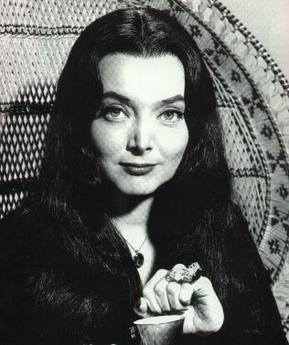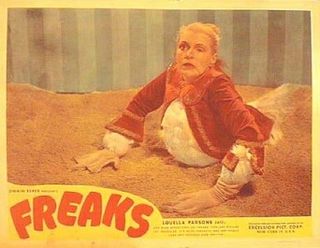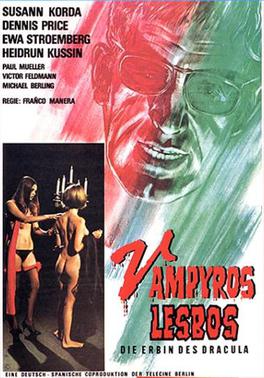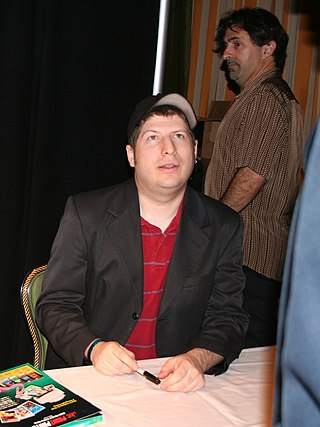
Edward Davis Wood Jr. was an American filmmaker, actor, screenwriter, and pulp novel author.

Orgy of the Dead is a 1965 American erotic horror film directed by Stephen C. Apostolof and written by cult film director Ed Wood, who also adapted the screenplay into a novel. The film belongs to the genre of "nudie-cuties", defined as narrative-based films featuring female nudity that originated from earlier films featuring striptease performances and burlesque shows.

Cassandra Gay Peterson is an American actress best known for her portrayal of the horror hostess character Elvira, Mistress of the Dark. Peterson gained fame on Los Angeles television station KHJ-TV in her stage persona as Elvira, hosting Elvira's Movie Macabre, a weekly B movie presentation. A member of the Los Angeles-based improvisational and sketch comedy troupe The Groundlings, Peterson based her Elvira persona in part on a "Valley girl"-type character she created while a member of the troupe.

Morticia Addams is a fictional character from the Addams Family multimedia franchise created by American Charles Addams in 1933. She plays the role of the family's reserved matriarch. Morticia Addams has been portrayed by several actresses in various Addams Family media, including Carolyn Jones in the television series The Addams Family (1964), Anjelica Huston in the feature films The Addams Family (1991) and Addams Family Values (1993), and Catherine Zeta-Jones in the streaming television series Wednesday (2022).

John Zacherle was an American television host, radio personality, singer, and voice actor. He was best known for his long career as a television horror host, often broadcasting horror films in Philadelphia and New York City in the 1950s and 1960s. Best known for his character of "Roland/Zacherley", he also did voice work for films, and recorded the top ten novelty rock and roll song "Dinner With Drac" in 1958. He also edited two collections of horror stories, Zacherley's Vulture Stew and Zacherley's Midnight Snacks.

Maila Elizabeth Syrjäniemi, known professionally as Maila Nurmi, was an American actress who created the campy 1950s character Vampira.

The term midnight movie is rooted in the practice that emerged in the 1950s of local television stations around the United States airing low-budget genre films as late-night programming, often with a host delivering ironic asides. As a cinematic phenomenon, the midnight screening of offbeat movies began in the early 1970s in a few urban centers, particularly in New York City with screenings of El Topo at the Elgin Theater, eventually spreading across the country. The screening of non-mainstream pictures at midnight was aimed at building a cult film audience, encouraging repeat viewing and social interaction in what was originally a countercultural setting.

Vampyros Lesbos is a 1971 West German-Spanish erotic horror film directed and co-written by Jesús Franco. The film stars Ewa Strömberg as Linda Westinghouse, an American who works in a Turkish legal firm. Westinghouse has a series of erotic dreams that involve a mysterious vampire woman who seduces her before feeding on her blood. When she travels to an island to settle an inheritance, Linda recognizes a woman as the vampire from her dreams.
A horror host is a person who acts as the host or presenter of a program where horror films and low-budget B movies are shown on television or the Internet. Usually the host assumes a horror-themed persona, often a campy or humorous one. Generally there are breaks in the film where the host comments on various aspects of the movie. Many horror host shows also include skits involving the hosts themselves, sometimes with a sidekick or other supporting characters.

Truth or Scare is an American television series on the Discovery Kids network. The show aired from October 25, 2001, to January 1, 2003. It was hosted by Michelle Trachtenberg in a style similar to Maila Nurmi as horror host "Vampira" and Cassandra Peterson as horror host "Elvira, Mistress of the Dark." The series first aired on Discovery Kids as a part of the network's Scary Saturday Night Sleepover lineup. After the series ended, reruns of the show aired on The Hub until October 29, 2012.

Lily Munster is a fictional character in the CBS sitcom, The Munsters, originally played by Yvonne De Carlo. The matriarch of the Munster household, Lily is a vampire. The role was later played by Lee Meriwether in The Munsters Today and by Portia de Rossi in the unsold 2012 pilot Mockingbird Lane.

Dracula is a stage play written by the Irish actor and playwright Hamilton Deane in 1924, then revised by the American writer John L. Balderston in 1927. It was the first authorized adaptation of Bram Stoker's 1897 novel Dracula. After touring in England, the original version of the play appeared at London's Little Theatre in July 1927, where it was seen by the American producer Horace Liveright. Liveright asked Balderston to revise the play for a Broadway production that opened at the Fulton Theatre in October 1927. This production starred Bela Lugosi in his first major English-speaking role.
La Commedia del Sangue: Vampyr Theatre (1992–1997) was a series of plays on the theme of vampires, first performed in New York City. It was started by playwright Tony Sokol as an extension of his 1986 show "I was Thirsty and You Drowned Me," a vampire ritual performance piece Sokol performed at the Anarchist's Switchboard, Centerfold and other clubs. The first Vampyr Theatre performance was at Le Bar Bat in May 1992. Sokol had placed ads in the back pages of New York City newspapers asking, "Are you a vampire?" eventually interviewing hundreds of self-professed vampires. These interviews became the framework for the 13 plays he wrote for La Commedia del Sangue.

Kevin Sean Michaels is an American film director, artist, producer and entertainer.

Plan 9 from Outer Space is a 1957 American independent science fiction-horror film produced, written, directed, and edited by Ed Wood. The film was shot in black-and-white in November 1956 and premiered on March 15, 1957 at the Carlton Theatre in Los Angeles. Retitled Plan 9 from Outer Space, it went into general release in April 1959 in Texas and several other Southern states before being sold to television in 1961.
Shock Theater is a package of 52 pre-1948 classic horror films from Universal Studios released for television syndication in October 1957 by Screen Gems, the television subsidiary of Columbia Pictures. The Shock Theater package included Dracula, Frankenstein, The Mummy, The Invisible Man and The Wolf Man as well as a few non-horror spy and mystery films. A second package, Son of Shock, was released for television by Screen Gems in 1958, with 20 horror films from both Universal and Columbia.

Elvira's Movie Macabre, or simply Movie Macabre, is an American hosted horror movie television program that originally aired locally from 1981 to 1986. The show features B movies, particularly those in the horror and science fiction genres, and is hosted by Elvira, a character with a black dress and heaven bump hairstyle, played by Cassandra Peterson. Elvira occasionally interrupts the films with comments and jokes, and in some episodes receives phone calls from a character called "the Breather".
Hunt Stromberg Jr. was a Broadway, radio and television producer best remembered for the discovery and casting of Maila Nurmi as Vampira, and for producing the 1973 film Frankenstein: The True Story.
Suzanne Waldron, better known by her alias "Tarantula Ghoul", was an American actress, television hostess, and musician. Between 1957 and 1959, she hosted the cult favorite program House of Horror on the Portland-based television station KPTV. With her backing band the Gravediggers, Tarantula Ghoul recorded "King Kong" and "Graveyard Rock", the latter of which became associated and popularized with Halloween-themed music. Following her role as Tarantula Ghoul, Waldron continued to act in the 1960s and 1970s.














